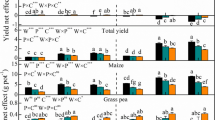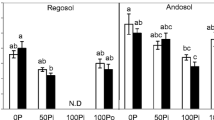Abstract
Aims
Plant-plant interactions are determined by resource availability. However, its responses to differences in soil phosphorus (P) and water and the rhizospheric driving mechanism have not been systematically revealed.
Methods
A pot-culture experiment was conducted in monoculture and in mixture with maize and grass pea. Resource stress treatments were created by organic and inorganic P applications (phytate and KH2PO4) as well as drought and well-watered treatments to address the above issue.
Results
Intercropping increased system yield and biomass by 3.5% and 4.5% on average in soils with sufficient P and water, and by 12.0% and 11.7% under stressful conditions respectively. With increasing water and P availability, the yield-based interaction types transited from mutually facilitated to maize facilitated with grass pea as facilitator. Comparatively, the biomass-based facilitation shifting from maize facilitated and grass pea neutral to both being facilitated with increasing stress. This shift was probably mediated by complementary use of soil water in the two species, and rhizospheric acidification in grass pea. Also, rhizospheric interactions promoted phosphatase secretion by 5.3–22.2%, and mobilized organic P to buffer P limitation under P-deficient soils. Regardless of crop species, reproductive and vegetative biomass fell into a typical allometric pattern (α > 1). The rhizospheric interactions drove the differentiated biomass allocation patterns and the species-specific interaction transition.
Conclusion
High P and water environments intensified the asymmetric interspecific competition. The trait-dependent facilitation shift was mechanically driven by rhizospheric interaction in intercropping systems. The findings update the understanding on stress gradient hypothesis in a modified model.









Similar content being viewed by others
Data availability
The datasets generated during and/or analysed during the current study are available from the corresponding author on reasonable request.
References
Armas C, Ordiales R, Pugnaire FI (2004) Measuring plant interactions: A new comparative index. Ecology 85:2682–2686. https://doi.org/10.1890/03-0650
Belay D, Schulthess F, Omwega C (2009) The profitability of maize-haricot bean intercropping techniques to control maize stem borers under low pest densities in Ethiopia. Phytoparasitica 37:43–50. https://doi.org/10.1007/s12600-008-0002-7
Bertness MD, Callaway RM (1994) Positive interactions in communities. Trends Ecol Evol 9:191–193. https://doi.org/10.1201/9780203738559
Betencourt E, Duputel M, Colomb B et al (2012) Intercropping promotes the ability of durum wheat and chickpea to increase rhizosphere phosphorus availability in a low P soil. Soil Biol Biochem 46:181–190. https://doi.org/10.1016/j.soilbio.2011.11.015
Bulleri F, Bruno JF, Silliman BR, Stachowicz JJ (2016) Facilitation and the niche: Implications for coexistence, range shifts and ecosystem functioning. Funct Ecol 30:70–78. https://doi.org/10.1111/1365-2435.12528
Callaway RM (1995) Positive interactions among plants. Bot Rev 61:306–349. https://doi.org/10.1007/BF02912621
Cardinale BJ, Duffy JE, Gonzalez A et al (2012) Biodiversity loss and its impact on humanity. Nature 486:59–67. https://doi.org/10.1038/nature11148
Devau N, Hinsinger P, Le Cadre E, Gérard F (2011) Root-induced processes controlling phosphate availability in soils with contrasted P-fertilized treatments. Plant Soil 348:203–218. https://doi.org/10.1007/s11104-011-0935-3
Dissanayaka DMSB, Maruyama H, Masuda G, Wasaki J (2015) Interspecific facilitation of P acquisition in intercropping of maize with white lupin in two contrasting soils as influenced by different rates and forms of P supply. Plant Soil 390:223–236. https://doi.org/10.1007/s11104-015-2392-x
Duchene O, Vian JF, Celette F (2017) Intercropping with legume for agroecological cropping systems: Complementarity and facilitation processes and the importance of soil microorganisms. A review. Agric Ecosyst Environ 240:148–161. https://doi.org/10.1016/j.agee.2017.02.019
Echarte L, Maggiora A, Della, Cerrudo D et al (2011) Yield response to plant density of maize and sunflower intercropped with soybean. F Crop Res 121:423–429. https://doi.org/10.1016/j.fcr.2011.01.011
Farooq M, Siddique KHM (2016) Research and developmental issues in dryland agriculture. In: Farooq M, Siddique KHM (eds) Innovations in dryland agriculture. Springer International Publishing, Cham, pp 31–46
Gallien L, Zurell D, Zimmermann NE (2018) Frequency and intensity of facilitation reveal opposing patterns along a stress gradient. Ecol Evol 8:2171–2181. https://doi.org/10.1002/ece3.3855
Gentle CB, Duggin JA (1997) Allelopathy as a competitive strategy in persistent thickets of Lantana camara L. in three Australian forest communities. Plant Ecol 132:85–95. https://doi.org/10.1023/A:1009707404802
George TS, Gregory PJ, Robinson JS et al (2002) Utilisation of soil organic P by agroforestry and crop species in the field, western Kenya. Plant Soil 246:53–63. https://doi.org/10.1023/A:1021575532546
Gilbert GA, Knight JD, Vance CP, Allan DL (1999) Acid phosphatase activity in phosphorus-deficient white lupin roots. Plant Cell Environ 22:801–810. https://doi.org/10.1046/j.1365-3040.1999.00441.x
Grace JB (1995) On the measurement of plant competition intensity. Ecology 76:305–308. https://doi.org/10.2307/1940651
Harley CDG (2011) Climate change, keystone predation, and biodiversity loss. Sci (80-) 334:1124–1127. https://doi.org/10.1126/science.1210199
He Q, Bertness MD, Altieri AH (2013) Global shifts towards positive species interactions with increasing environmental stress. Ecol Lett 16:695–706. https://doi.org/10.1111/ele.12080
He Q, Cui B, Bertness MD et al (2012) Testing the importance of plant strategies on facilitation using congeners in a coastal community. Ecology 93:2023–2029. https://doi.org/10.1890/12-0241.1
Julian S, Huxley MA (1932) Problems of relative growth. Methuen Co, London. https://doi.org/10.1093/aesa/25.4.757
Kahmen A, Perner J, Buchmann N (2005) Diversity-dependent productivity in semi-natural grasslands following climate perturbations. Funct Ecol 19:594–601. https://doi.org/10.1111/j.1365-2435.2005.01001.x
Layek J, Shivakumar BG, Rana DS et al (2014) Soybean–cereal intercropping systems as influenced by nitrogen nutrition. Agron J 106:1933–1946. https://doi.org/10.2134/agronj13.0521
Li B, Li YY, Wu HM et al (2016) Root exudates drive interspecific facilitation by enhancing nodulation and N2 fixation. Proc Natl Acad Sci U S A 113:6496–6501. https://doi.org/10.1073/pnas.1523580113
Li C, Hoffland E, Kuyper TW et al (2020) Syndromes of production in intercropping impact yield gains. Nat Plants 6:653–660. https://doi.org/10.1038/s41477-020-0680-9
Li H, Shen J, Zhang F et al (2008) Dynamics of phosphorus fractions in the rhizosphere of common bean (Phaseolus vulgaris L.) and durum wheat (Triticum turgidum durum L.) grown in monocropping and intercropping systems. Plant Soil 312:139–150. https://doi.org/10.1007/s11104-007-9512-1
Li H, Zhang F, Rengel Z, Shen J (2013a) Rhizosphere properties in monocropping and intercropping systems between faba bean (Vicia faba L.) and maize (Zea mays L.) grown in a calcareous soil. Crop Pasture Sci 64:976–984. https://doi.org/10.1071/CP13268
Li L, Zhang L, Zhang F (2013b) Crop mixtures and the mechanisms of overyielding. Encycl Biodivers 2:382–395. https://doi.org/10.1016/B978-0-12-384719-5.00363-4
Li L, Tilman D, Lambers H, Zhang FS (2014) Plant diversity and overyielding: Insights from belowground facilitation of intercropping in agriculture. New Phytol 203:63–69. https://doi.org/10.1111/nph.12778
Li L, Yang S, Li X et al (1999) Interspecific complementary and competitive interactions between intercropped maize and faba bean. Plant Soil 212:105–114. https://doi.org/10.1023/A:1004656205144
Liancourt P, Callaway RM, Michalet R (2005) Stress tolerance and competitive-response ability determine the outcome of biotic interactions. Ecology 86:1611–1618. https://doi.org/10.1890/04-1398
Maestre FT, Callaway RM, Valladares F, Lortie CJ (2009) Refining the stress-gradient hypothesis for competition and facilitation in plant communities. J Ecol 97:199–205. https://doi.org/10.1111/j.1365-2745.2008.01476.x
Mo F, Han J, Wen XX et al (2020) Quantifying regional effects of plastic mulch on soil nitrogen pools, cycles, and fluxes in rain-fed agroecosystems of the Loess Plateau. L Degrad Dev 31:1675–1687. https://doi.org/10.1002/ldr.3548
Nelson DW, Sommers LE (1980) Total nitrogen analysis of soil and plant tissues. J Assoc Off Anal Chem 63:770–778. https://doi.org/10.1093/jaoac/63.4.770
Oelmann Y, Lange M, Leimer S et al (2021) Above- and belowground biodiversity jointly tighten the P cycle in agricultural grasslands. Nat Commun 12:4431. https://doi.org/10.1038/s41467-021-24714-4
Pelzer E, Bazot M, Makowski D et al (2012) Pea-wheat intercrops in low-input conditions combine high economic performances and low environmental impacts. Eur J Agron 40:39–53. https://doi.org/10.1016/j.eja.2012.01.010
Raza MA, Cui L, Qin R et al (2020) Strip-width determines competitive strengths and grain yields of intercrop species in relay intercropping system. Sci Rep 10:1–12. https://doi.org/10.1038/s41598-020-78719-y
Schöb C, Armas C, Pugnaire FI (2013) Direct and indirect interactions co-determine species composition in nurse plant systems. Oikos 122:1371–1379. https://doi.org/10.1111/j.1600-0706.2013.00390.x
Searle PGE, Yuthapong C, Sheddon DC, Nance RA (1981) Effect of maize + legume intercropping systems and fertilizer nitrogen on crop yields and residual nitrogen. F Crop Res 4:133–145. https://doi.org/10.1016/0378-4290(81)90063-0
Shukla N, Awasthi RP, Rawat L, Kumar J (2012) Biochemical and physiological responses of rice (Oryza sativa L.) as influenced by Trichoderma harzianum under drought stress. Plant Physiol Biochem 54:78–88. https://doi.org/10.1016/j.plaphy.2012.02.001
Tabatabai MA, Bremner JM (1969) Use of p-nitrophenyl phosphate for assay of soil phosphatase activity. Soil Biol Biochem 1:301–307. https://doi.org/10.1016/0038-0717(69)90012-1
Tamburini G, Bommarco R, Wanger TC et al (2020) Agricultural diversification promotes multiple ecosystem services without compromising yield. Sci Adv 6:eaba1715. https://doi.org/10.1126/SCIADV.ABA1715
Tong Y, Gabriel-Neumann E, Krumbein A et al (2015) Interactive effects of arbuscular mycorrhizal fungi and intercropping with sesame (Sesamum indicum) on the glucosinolate profile in broccoli (Brassica oleracea var. Italica). Environ Exp Bot 109:288–295. https://doi.org/10.1016/j.envexpbot.2014.06.008
Turner BL (2008) Resource partitioning for soil phosphorus: A hypothesis. J Ecol 96:698–702. https://doi.org/10.1111/j.1365-2745.2008.01384.x
Turner NC (2018) Imposing and maintaining soil water deficits in drought studies in pots. Plant Soil 439:45–55. https://doi.org/10.1007/s11104-018-3893-1
Tylianakis JM, Didham RK, Bascompte J, Wardle DA (2008) Global change and species interactions in terrestrial ecosystems. Ecol Lett 11:1351–1363. https://doi.org/10.1111/j.1461-0248.2008.01250.x
Vinet L, Zhedanov A (2011) A “missing” family of classical orthogonal polynomials. J Phys A Math Theor 44:1689–1699. https://doi.org/10.1088/1751-8113/44/8/085201
Walker JA, King JR (2009) Above- and below-ground competition between Kura clover (Trifolium ambiguum) and meadow bromegrass (Bromus biebersteinii): A greenhouse study. Can J Plant Sci 89:21–27. https://doi.org/10.4141/CJPS08010
Wang L, Hou B, Zhang D et al (2020) The niche complementarity driven by rhizosphere interactions enhances phosphorus-use efficiency in maize/alfalfa mixture. Food Energy Secur 9:1–14. https://doi.org/10.1002/fes3.252
Wang X, Deng X, Pu T et al (2017) Contribution of interspecific interactions and phosphorus application to increasing soil phosphorus availability in relay intercropping systems. F Crop Res 204:12–22. https://doi.org/10.1016/j.fcr.2016.12.020
Wang Y, Marschner P, Zhang F (2012) Phosphorus pools and other soil properties in the rhizosphere of wheat and legumes growing in three soils in monoculture or as a mixture of wheat and legume. Plant Soil 354:283–298. https://doi.org/10.1007/s11104-011-1065-7
Warton DI, Weber NC (2002) Common slope tests for bivariate errors-in-variables models. Biometrical J 44:161–174. https://doi.org/10.1002/1521-4036(200203)44:23.0.CO;2-N
Weiner J (2004) Allocation, plasticity and allometry in plants. Perspect Plant Ecol Evol Syst 6:207–215. https://doi.org/10.1078/1433-8319-00083
Weiner J, Rosenmeier L, Massoni ES et al (2009) Is reproductive allocation in Senecio vulgaris plastic? Botany 87:475–481. https://doi.org/10.1139/B09-012
Westerman RL (1990) Soil testing and plant analysis, 3rd edn. Soil Science Society of America, Madison, WI
Willey RW (1990) Resource use in intercropping systems. Agric Water Manag 17:215–231. https://doi.org/10.1016/0378-3774(90)90069-B
Yang G, Ryo M, Roy J et al (2021) Plant and soil biodiversity have non-substitutable stabilising effects on biomass production. Ecol Lett 24:1582–1593. https://doi.org/10.1111/ele.13769
Zhang D, Zhang C, Tang X et al (2016) Increased soil phosphorus availability induced by faba bean root exudation stimulates root growth and phosphorus uptake in neighbouring maize. New Phytol 209:823–831. https://doi.org/10.1111/nph.13613
Zhang G, Yang Z, Dong S (2011) Interspecific competitiveness affects the total biomass yield in an alfalfa and corn intercropping system. F Crop Res 124:66–73. https://doi.org/10.1016/j.fcr.2011.06.006
Zhu SG, Cheng ZG, Batool A et al (2022) Plant facilitation shifts along with soil moisture and phosphorus gradients via rhizosphere interaction in the maize-grass pea intercropping system. Ecol Indic 139:108901. https://doi.org/10.1016/j.ecolind.2022.108901
Acknowledgements
We thank the College of Ecology of Lanzhou University for providing experimental sites and instrument support, and we thank Minha Naseer for editing this manuscript.
Funding
The National Natural Science Foundation of China (32161143012), Key Research and Development Program of Gansu Province (20YF8WA083), Fundamental Research Funds for the Central Universities (lzujbky-2021-kb07) and “111” Program (BP0719040).
Author information
Authors and Affiliations
Contributions
Y.C. Xiong, S.G. Zhu, H. Zhu, and Z.G. Cheng designed experiments; R. Zhou, Y.M. Yang, J. Wang, W. Wang and B.Z. Wang performed experiment and analyzed the data; Y.C. Xiong, S.G. Zhu and H.Y. Tao wrote the manuscript; Y.C. Xiong and S.G. Zhu revised the manuscript. All authors read and approved the final manuscript.
Corresponding authors
Ethics declarations
Humans and/or animals
This article does not contain any studies with human or animal subjects performed by any of the authors.
Ethics approval
Not applicable.
Consent to participate
The authors agreed to participate.
Conflicts of interest/Competing interests
The authors declare that they have no competing interests.
Additional information
Responsible Editor: Dorte Bodin Dresbøll.
Publisher’s note
Springer Nature remains neutral with regard to jurisdictional claims in published maps and institutional affiliations.
Rights and permissions
Springer Nature or its licensor holds exclusive rights to this article under a publishing agreement with the author(s) or other rightsholder(s); author self-archiving of the accepted manuscript version of this article is solely governed by the terms of such publishing agreement and applicable law.
About this article
Cite this article
Zhu, SG., Zhu, H., Cheng, ZG. et al. Soil water and phosphorus availability determines plant-plant facilitation in maize-grass pea intercropping system. Plant Soil 482, 451–467 (2023). https://doi.org/10.1007/s11104-022-05701-0
Received:
Accepted:
Published:
Issue Date:
DOI: https://doi.org/10.1007/s11104-022-05701-0




